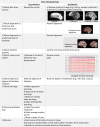Quality control in resting-state fMRI: the benefits of visual inspection
- PMID: 37214404
- PMCID: PMC10192849
- DOI: 10.3389/fnins.2023.1076824
Quality control in resting-state fMRI: the benefits of visual inspection
Abstract
Background: A variety of quality control (QC) approaches are employed in resting-state functional magnetic resonance imaging (rs-fMRI) to determine data quality and ultimately inclusion or exclusion of a fMRI data set in group analysis. Reliability of rs-fMRI data can be improved by censoring or "scrubbing" volumes affected by motion. While censoring preserves the integrity of participant-level data, including excessively censored data sets in group analyses may add noise. Quantitative motion-related metrics are frequently reported in the literature; however, qualitative visual inspection can sometimes catch errors or other issues that may be missed by quantitative metrics alone. In this paper, we describe our methods for performing QC of rs-fMRI data using software-generated quantitative and qualitative output and trained visual inspection.
Results: The data provided for this QC paper had relatively low motion-censoring, thus quantitative QC resulted in no exclusions. Qualitative checks of the data resulted in limited exclusions due to potential incidental findings and failed pre-processing scripts.
Conclusion: Visual inspection in addition to the review of quantitative QC metrics is an important component to ensure high quality and accuracy in rs-fMRI data analysis.
Keywords: artifacts; functional magnetic resonance imaging (fMRI); quality control; reproducibility of results; resting state—fMRI.
Copyright © 2023 Lepping, Yeh, McPherson, Brucks, Sabati, Karcher, Brooks, Habiger, Papa and Martin.
Conflict of interest statement
The authors declare that the research was conducted in the absence of any commercial or financial relationships that could be construed as a potential conflict of interest.
Figures
Similar articles
-
Quality control procedures and metrics for resting-state functional MRI.Front Neuroimaging. 2023 Mar 13;2:1072927. doi: 10.3389/fnimg.2023.1072927. eCollection 2023. Front Neuroimaging. 2023. PMID: 37554646 Free PMC article.
-
Balancing Data Quality and Bias: Investigating Functional Connectivity Exclusions in the Adolescent Brain Cognitive Development℠ (ABCD Study) Across Quality Control Pathways.Hum Brain Mapp. 2025 Jan;46(1):e70094. doi: 10.1002/hbm.70094. Hum Brain Mapp. 2025. PMID: 39788921 Free PMC article.
-
A multi-measure approach for assessing the performance of fMRI preprocessing strategies in resting-state functional connectivity.Magn Reson Imaging. 2022 Jan;85:228-250. doi: 10.1016/j.mri.2021.10.028. Epub 2021 Oct 27. Magn Reson Imaging. 2022. PMID: 34715292
-
Resting State fMRI: Going Through the Motions.Front Neurosci. 2019 Aug 13;13:825. doi: 10.3389/fnins.2019.00825. eCollection 2019. Front Neurosci. 2019. PMID: 31456656 Free PMC article. Review.
-
Head Motion and Correction Methods in Resting-state Functional MRI.Magn Reson Med Sci. 2016;15(2):178-86. doi: 10.2463/mrms.rev.2015-0060. Epub 2015 Dec 22. Magn Reson Med Sci. 2016. PMID: 26701695 Free PMC article. Review.
Cited by
-
Expression of microRNA induced by postoperative delirium-like behavior is associated with long-term default mode network disruption: Sequencing and a secondary analysis of resting-state fMRI data.CNS Neurosci Ther. 2024 Sep;30(9):e70038. doi: 10.1111/cns.70038. CNS Neurosci Ther. 2024. PMID: 39317458 Free PMC article.
-
A Set of FMRI Quality Control Tools in AFNI: Systematic, in-depth and interactive QC with afni_proc.py and more.bioRxiv [Preprint]. 2024 Jun 11:2024.03.27.586976. doi: 10.1101/2024.03.27.586976. bioRxiv. 2024. Update in: Imaging Neurosci (Camb). 2024 Aug 02;2:1-39. doi: 10.1162/imag_a_00246. PMID: 38585923 Free PMC article. Updated. Preprint.
-
Stationarity assessment of resting state condition via permutation entropy on EEG recordings.Sci Rep. 2025 Jan 3;15(1):698. doi: 10.1038/s41598-024-82089-0. Sci Rep. 2025. PMID: 39753595 Free PMC article.
-
A Set of FMRI Quality Control Tools in AFNI: Systematic, in-depth, and interactive QC with afni_proc.py and more.Imaging Neurosci (Camb). 2024 Aug 2;2:1-39. doi: 10.1162/imag_a_00246. eCollection 2024 Aug 1. Imaging Neurosci (Camb). 2024. PMID: 39257641 Free PMC article.
-
Processing, evaluating, and understanding FMRI data with afni_proc.py.Imaging Neurosci (Camb). 2024 Nov 12;2:1-52. doi: 10.1162/imag_a_00347. eCollection 2024 Nov 1. Imaging Neurosci (Camb). 2024. PMID: 39575179 Free PMC article.
References
-
- Beall E. B., Lowe M. J. (2014). SimPACE: generating simulated motion corrupted BOLD data with synthetic-navigated acquisition for the development and evaluation of SLOMOCO: a new, highly effective slicewise motion correction. NeuroImage 101, 21–34. doi: 10.1016/j.neuroimage.2014.06.038, PMID: - DOI - PMC - PubMed
LinkOut - more resources
Full Text Sources



